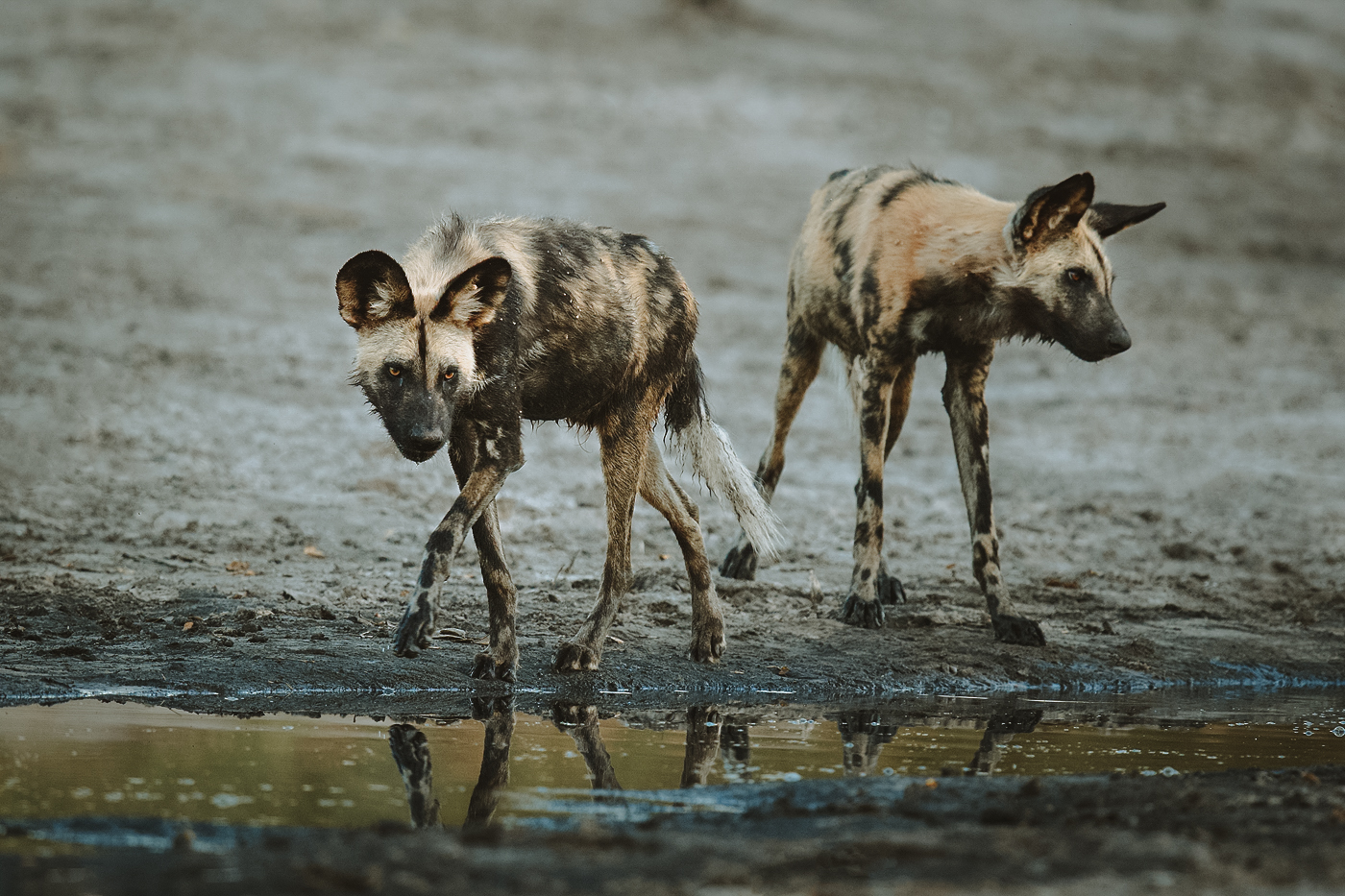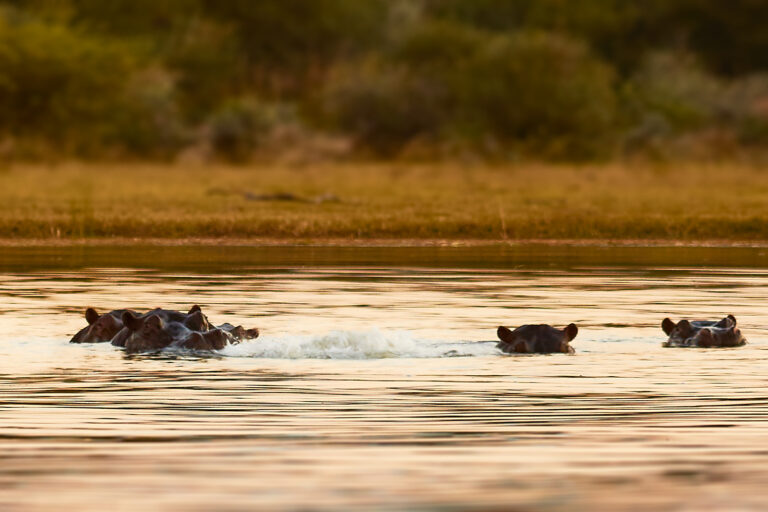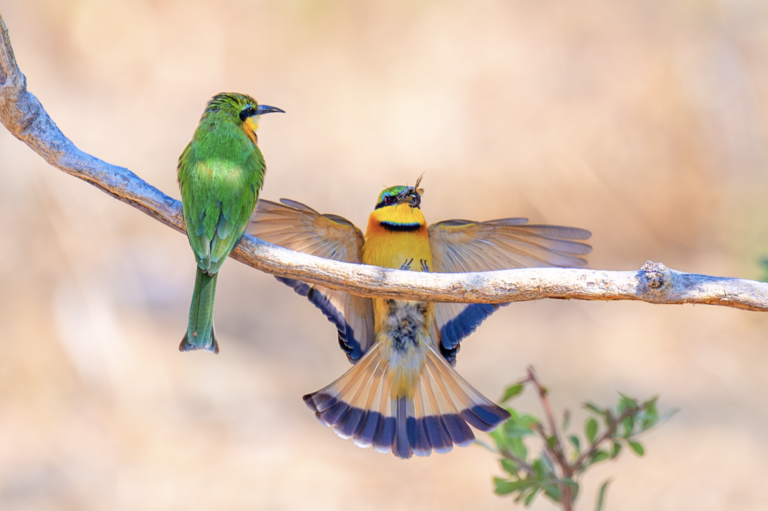The African wild dog (Lycaon pictus) goes by many names: painted wolf, Cape hunting dog, and painted dog, to name a few. Regardless of the moniker, this singular species stands out as Africa’s largest wild canine and the only surviving member of the genus Lycaon.
Renowned for its vibrant patchwork coat and strong pack dynamics, the African wild dog is a testament to the wonders of evolution. Yet, despite its endurance and adaptability, only around 6,600 adults, including about 1,400 mature individuals, remain across the continent.
In this article, we look at these endangered species in detail and how fascinating it is to share spaces with them.
What Makes the African Wild Dog Special?
The African wild dog (Lycaon pictus)—sometimes called the painted dog, Cape hunting dog, or painted wolf—stands out among Africa’s iconic predators due to its striking coat patterns and strong social bonds.

African wild dogs have only four toes per foot, which is unique among canids and contributes to their speed and maneuverability. Considered Africa’s largest wild canine, this species evolved specialized teeth and unique limb structures perfectly adapted for endurance hunting. Yet, despite their prowess, only around 6,600 adults remain, scattered across fragmented habitats.
Quick Fact: The African wild dog has been classified as Endangered by the IUCN Red List since 1990.
Evolution and Taxonomy of the African Wild Dog
First described as Hyaena picta in 1820, the African wild dog was later placed in the genus Lycaon, separating it from the more general canid family (Canis).
DNA evidence indicates that this lineage diverged from other wolves, jackals, and coyotes around 1.7 million years ago, making the wild dog one of the oldest canid species on Earth.
Did You Know? Fossil remains in the Middle East and North Africa suggest a broader historical range than we see today.
Beyond the scientific realm, the African wild dog has figured in writings for millennia. As early as the third century AD, Solinus noted an unusually colored, wolf-like animal with a mane, likely referencing this species.
The revered status of these dogs also appears in prehistoric and ancient cultures: the San people of Southern Africa, for instance, regarded them with mysticism, and early Egyptian artifacts depict animals closely resembling painted dogs.
Unmistakable Appearance & Coat Variations
The African wild dog is famed for its unique coat, an ever-shifting mosaic of black, brown, white, and yellow blotches. Each pattern is as distinct as a fingerprint, helping individuals within a pack identify one another from considerable distances. The coat features patches of yellow fur among other colors, contributing to its distinct appearance.
Unlike many other canids, they possess bristle-like hairs with little to no underfur. Older members of a pack often become relatively hairless, with the remaining patches of color and dark skin still offering a striking appearance.
Variations exist across their range—some populations, especially in East Africa, are predominantly darker with slight yellow markings, whereas those in Southern Africa can display more intense contrasts of orange, black, and white.
Size-wise, these painted wolves stand around 60 to 75 centimeters at the shoulder and weigh between 18 and 36 kilograms, with females tending to be slightly smaller.
They also have large, rounded ears that serve multiple functions: capturing distant sounds and regulating body temperature by dispersing heat in harsh climates.
Social Hierarchy: The Power of the Pack
Perhaps what fascinates many observers most about the African wild dog is its elaborate social structure. The dominant female, typically the oldest female, plays a crucial role in the pack’s social structure and breeding. Packs typically revolve around a dominant breeding pair, although the entire group contributes to communal duties in a manner rarely seen among other top predators.
Hunting is a team endeavor. Dominant dogs initiate decision-making processes within the pack by sneezing, a behavior known as ‘sneeze communication.’ These dogs are known to run prey—often impala, kudu, and wildebeest calves—to exhaustion, making use of their impressive stamina and speed, which can exceed 40 miles per hour.
When they succeed, their pack cohesion stands out. In an unusual twist for large carnivores, pups feed first at kills. Adults wait patiently, even regurgitating food for their younger or weaker pack mates.
This instinctive care extends to injured or sick adults, reflecting a familial bond that bolsters their collective survival. Remarkably, males often outnumber females by about three to one, largely because female pups disperse from the natal pack, preventing inbreeding. This ratio further emphasizes the stability and unity within the group.
Despite their cooperative nature, African wild dogs face formidable natural enemies. Lions kill them on sight whenever possible, while spotted hyenas frequently steal their hard-earned prey through intimidation and strength of numbers. Nonetheless, the dogs’ persistent group strategies allow them to defend kills when they can coordinate quickly.
Pack Dynamics
- Dominant breeding pairs: Typically, an alpha female and alpha male lead each pack.
- Cooperative living: African wild dogs share food with pups and injured members, even regurgitating meals to feed those who cannot hunt. The entire pack contributes to the nurturing and feeding of the dominant pair’s pups, showcasing their strong social bonds.
- High hunting success: Researchers estimate that 60–90% of their chases end with a kill—making them more successful hunters than even lions.
Pup-First Feeding
In an unusual twist for predators, pups get priority at kills. Adults ensure the youngest pack members have full bellies before feeding themselves, reflecting their extraordinary family-centric approach.
Hunting Techniques & Favorite Prey
These canines are endurance specialists, pursuing prey relentlessly over long distances:
- Primary targets: Medium-sized ungulates such as impala, kudu, and wildebeest calves. African wild dogs prefer wild prey over livestock, which helps to understand their dietary habits and the conflicts that arise with human activities.
- Hunting style: Chase prey at speeds up to 66 km/h (41 mph) and rely on pack coordination to outmaneuver prey. Their primary preference remains for wild animals, showcasing their natural hunting instincts.
- Competition: Lions often kill wild dogs on sight, while spotted hyenas frequently harass them to steal their hard-earned meals.
Quick Stat: The African wild dog’s specialized dentition—a set of razor-sharp carnassial teeth—allows it to consume meals quickly, reducing the chance that bigger predators will snatch away their kills.
Ecological Importance
African wild dogs are not just fascinating predators; they are also crucial to the health of their ecosystems. As apex predators, they play a vital role in regulating the populations of their prey species, such as impala, kudu, and wildebeest calves. By keeping these herbivore populations in check, wild dogs prevent overgrazing, which allows vegetation to recover and thrive. This, in turn, benefits other species that share their habitat, creating a balanced and healthy ecosystem.
But the ecological contributions of African wild dogs don’t stop there. Their hunting activities contribute to nutrient cycling, enriching the soil and fostering plant growth. When wild dogs dig, they create pathways for water to flow, reducing erosion and improving soil quality. This digging activity also helps to aerate the soil, promoting the growth of various plant species.
Moreover, the presence of wild dogs can influence the behavior of other predators, such as lions and hyenas. This can lead to a cascading effect on the entire ecosystem, as the interactions between different predator species help to maintain a dynamic balance.
As a keystone species, African wild dogs are ecological architects, shaping their environment in ways that support a diverse range of species. Their loss could have significant consequences, leading to a decline in biodiversity and ecosystem function. Conservation efforts aimed at protecting African wild dogs and their habitats are crucial for maintaining the ecological integrity of sub-Saharan Africa.
In addition to their ecological importance, African wild dogs hold cultural significance for many indigenous communities. They are often revered as symbols of strength, unity, and perseverance, and feature prominently in traditional folklore and mythology.
Overall, African wild dogs are a vital component of their ecosystems. By protecting these incredible animals and their habitats, we can ensure the long-term survival of this iconic species and the many other species that depend on them.
Where to Spot African Wild Dogs: Key Wildlife Hotspots
Botswana
- Savuti (Chobe National Park): Known for its dramatic seasonal marshlands and abundant wildlife, Savuti offers a prime opportunity to catch glimpses of African wild dog packs hunting zebra or impala in open grasslands.
- Khwai Concession (Okavango Delta): This region, bordering Moremi Game Reserve, is celebrated for frequent sightings of wild dogs, particularly in areas where floodplains meet woodlands. Guides often track them at dawn when the dogs set off on their first hunt.
- Linyanti: The floodplains and dense woodlands of Linyanti also host viable wild dog populations, although sightings can be more sporadic.
Zimbabwe
- Hwange National Park: A stronghold for African wild dogs, with well-established packs that den here annually.
Tanzania & Kenya
- Serengeti & Maasai Mara: While famed for lion and cheetah populations, these iconic reserves also support smaller packs of African wild dogs, though sightings are rarer than in Botswana or Zimbabwe.
South Africa
- Kruger National Park: Boasts one of the most stable African wild dog populations in Southern Africa. Collaring and monitoring programs offer fascinating insights into pack movements.
Travel Tip: Enlisting expert local guides is the best way to locate African wild dogs in these vast wilderness areas. They track fresh footprints and listen for telltale vocalizations to pinpoint pack movements.
Current Population Status & Major Threats
Despite their status as supremely efficient predators, African wild dogs have faced severe decline over the last century.
Habitat fragmentation proves one of the biggest challenges, as expanding farmland and infrastructure reduce the large, continuous territories these dogs require. Human persecution arises when packs stray onto pastoral lands, occasionally hunting goats or cattle.
Training local farmers in livestock management techniques is crucial to mitigate conflicts between humans and wildlife, particularly concerning predation by African wild dogs. These techniques include practical solutions such as constructing bomas to protect livestock, aimed at promoting coexistence between agricultural practices and wildlife conservation.
With an estimated 6,600 adults, including 1,400 mature individuals, African wild dogs suffer from:
- Habitat Fragmentation: Expanding agriculture and settlements reduce their roaming space.
- Human-Wildlife Conflict: Pastoralists sometimes kill them when they prey on livestock.
- Diseases: Rabies and canine distemper—often contracted from domestic dogs—can decimate entire packs.
Their Endangered status underscores the urgency for targeted conservation efforts across sub-Saharan Africa. In fact, no subpopulation is believed to exceed 250 individuals, which has led to the African wild dog’s classification as Endangered by the IUCN Red List.
Conservation Efforts & Success Stories
Many conservation projects across sub-Saharan Africa work tirelessly to reverse the African wild dog’s decline. Researchers rely on GPS collaring to study pack movements and breeding success, information that guides the creation of wildlife corridors and protected areas.
Conservation groups play a crucial role in promoting positive perceptions of the African wild dog and advocating for their conservation through various initiatives. These groups are involved in creating protected wildlife corridors, reducing human-wild dog conflict, and educating communities about the benefits of preserving this endangered species.
Vaccination campaigns targeting domestic dogs near core wild dog habitats help contain rabies and distemper outbreaks. Community-based initiatives encourage local buy-in by highlighting the benefits of eco-tourism, reminding residents that sightings of painted wolves can attract high-value tourists.
In Botswana’s Okavango Delta, for example, collaboration between wildlife authorities and communities has led to a marked reduction in retaliatory killings and improved pack stability.
Similar progress is taking place in Zimbabwe’s Hwange National Park, where Painted Dog Conservation works closely with villagers to set up anti-poaching patrols and education programs.
Cultural and Historical Significance
Folklore and ancient art attest to the significance of African wild dogs in various cultures, from the reverence shown by the San people to the ambiguous portrayal in Ndebele myths.
Nevertheless, the modern term “wild dog” can carry negative connotations, prompting some organizations to champion alternatives like “painted dog” or “painted wolf,” both of which better capture the species’ beauty and unique ecology.
Here is what cultures say about the African wild Dog
- San People: Linked wild dogs to mystical powers; some believed shamans could assume the canines’ form.
- Ancient Egypt: Early depictions of multicolored dog-like figures are thought to represent Lycaon pictus, symbolizing order over chaos.
- Ndebele Folktales: Stories explain why wild dogs target zebras and impalas, highlighting cultural attitudes towards these predators.
Despite modern misconceptions, names like “painted wolf” and “painted dog” are increasingly promoted to reflect their ecological importance and counter negative connotations around “wild dogs.”
What You Can Do to Help
Support for African wild dog conservation can come in multiple forms. Donating to initiatives like Painted Dog Conservation or the African Wildlife Foundation helps fund research, vaccination programs, and habitat preservation.
Ethical tourism that focuses on low-impact safaris in places like Savuti and the Khwai Concession not only enriches visitors but also provides financial incentives to protect these canids.
Finally, spreading awareness about the vital role painted wolves play in regulating prey populations and maintaining ecosystem health fosters greater appreciation and empathy.
Conclusion
The African wild dog remains one of the most unique and socially complex predators in the animal kingdom.
Whether you’re exploring the vast floodplains of Khwai in Botswana or the sprawling savannas of Tanzania’s Serengeti, encountering a pack of these painted canines is an unforgettable experience.
Yet, due to threats like habitat loss, human-wildlife conflict, and disease, their existence hangs in the balance.
By championing community-based programs, supporting vaccine drives, and practicing ethical wildlife tourism, we can help conserve the remaining African wild dog populations.
In doing so, we preserve not just a species, but a vital element of Africa’s incredible tapestry of life.
Additional Resources
- IUCN Red List: African Wild Dog Profile
- Botswana Tourism: Wildlife Guides for Savuti, Khwai, and Linyanti
- Painted Dog Conservation: Official Initiatives in Zimbabwe
Frequently Asked Questions about African Wild Dogs
Can an African wild dog be a pet?
No, African wild dogs are not suitable as pets. They are wild animals with complex social structures and specific habitat needs that cannot be met in a domestic environment. Keeping them as pets is illegal in many places due to their endangered status.
Are African wild dogs aggressive to humans?
African wild dogs generally avoid human contact and are not known to be aggressive towards people. They are more focused on hunting their natural prey in the wild.
How many African wild dogs are left in 2025?
As of the latest estimates, there are approximately 6,600 adult African wild dogs remaining in the wild, with around 1,400 mature individuals. Conservation efforts are ongoing to stabilize and hopefully increase their population.
What dog is closest to the African wild dog?
The African wild dog is unique and does not have any direct domesticated counterparts. However, it belongs to the family Canidae, which includes other wild canids like wolves and jackals.
What’s the Difference Between Hyenas and African Wild Dogs?
While both are social carnivores found in Africa, hyenas and African wild dogs belong to different families. Hyenas are more closely related to cats, while wild dogs are canids. They also differ in physical appearance, social structure, and hunting techniques.
Why are African wild dogs also called painted wolves?
The name “painted wolf” comes from their distinctive coat patterns, which resemble a painted canvas. Each dog has a unique pattern of black, brown, white, and yellow fur, contributing to their nickname.
What is the main threat to African wild dogs?
The primary threats to African wild dogs include habitat loss, human-wildlife conflict, and diseases such as rabies and canine distemper. Conservation efforts focus on mitigating these threats to ensure the survival of this endangered species.
How do African wild dogs contribute to the ecosystem?
As apex predators, African wild dogs help regulate prey populations, preventing overgrazing and promoting biodiversity. Their hunting activities also contribute to nutrient cycling and soil aeration, benefiting the entire ecosystem.
How can I help in the conservation of African wild dogs?
You can support conservation efforts by donating to organizations like Painted Dog Conservation and the African Wildlife Foundation. Participating in ethical wildlife tourism and spreading awareness about the importance of preserving these animals also contributes to their conservation



